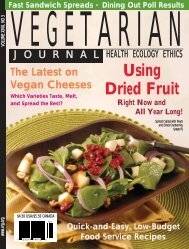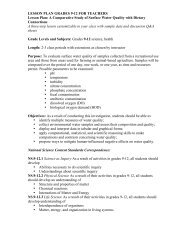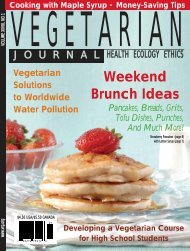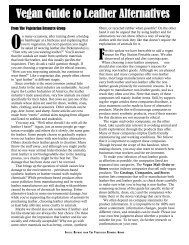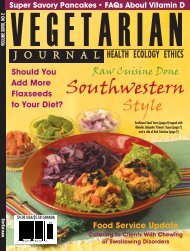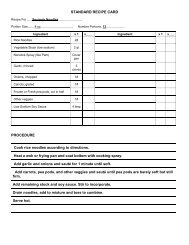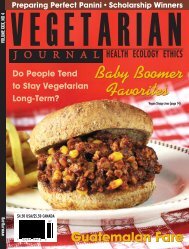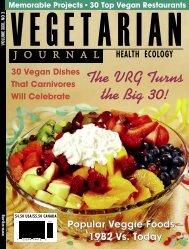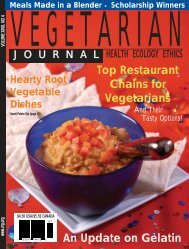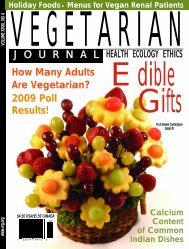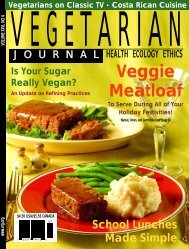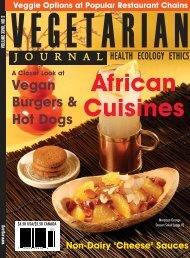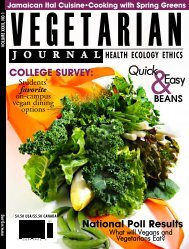Revamping a Vegetarian, Seventh-Day Adventist School Lunch ...
Revamping a Vegetarian, Seventh-Day Adventist School Lunch ...
Revamping a Vegetarian, Seventh-Day Adventist School Lunch ...
Create successful ePaper yourself
Turn your PDF publications into a flip-book with our unique Google optimized e-Paper software.
<strong>Revamping</strong> a <strong>Vegetarian</strong>, <strong>Seventh</strong>-<strong>Day</strong> <strong>Adventist</strong><strong>School</strong> <strong>Lunch</strong> ProgramBy Stephanie Gall, MS, RD and Megan Salazar, dietetic internAbstractIn an effort to improve the nutrition of the vegetarian lunch menu at Vista RidgeAcademy, a private <strong>Seventh</strong>-<strong>Day</strong> <strong>Adventist</strong> school in Colorado, the old menu was given anoverhaul. The new recipes chosen were incorporated into meals that offered a higherstandard of nutrient density than those set by the National <strong>School</strong> <strong>Lunch</strong> Program (NLSP)and also integrated nutrition standards from various Dietary Reference Intakes (DRIs) setby the American Dietetic Association. Additionally, the new menu incorporated more freshvegetables, fruits and whole grains but contained less sodium and fat. The resulting menuwas more balanced while still maintaining affordability and including foods which wereseasonally available. While many aspects of nutrition were improved in the process, thereare still many hurdles and challenges with the program. If these can be overcome, theschool lunch program at Vista Ridge Academy is sure to be a success as it gets refined forfuture years. The results from this project have implications in any school system looking toimprove their vegetarian offerings or incorporating meatless meals into the school week.IntroductionThe National <strong>School</strong> <strong>Lunch</strong> program (NSLP) is a federally funded meal program thatestablishes nutritional guidelines for school meals and provides assistance to certaineducational institutions. The program began in 1946 under the National <strong>School</strong> <strong>Lunch</strong> Actand has been highly successful in offering meals to all students from participating schools,including those who are on limited incomes (USDA, 2010).While nutritional guidelines exist under the NSLP, there are no recommendations orprocedures regarding which specific foods are served or how meals are prepared at theschool. The NSLP dietary guidelines state that school lunches must meet the followingparameters:• One-third the Recommended Dietary Allowances (RDA) for calories• Approximately 30% of total meal calories from fat• Less than 10% from saturated fat• One-third the RDA for protein, vitamin A, vitamin C, iron, and calciumThe NSLP has seen much success since its implementation and has coupled with otherprograms like the <strong>School</strong> Milk Program or the National <strong>School</strong> Breakfast Program. However,obesity continues to rise in America, becoming more prevalent in younger children in pastyears (USDA, 2010). Despite efforts to educate, soda consumption remains high, physicalfitness levels are low, and funding for after school wellness programs continues to be cut.To top this off, the NSLP does not provide funding adjustments for yearly changes in foodprices, include any fresh fruits, vegetables or whole grains, and does not prevent theoverconsumption of harmful nutrients like sodium. The Child Nutrition Act was due for arewrite in 2010 and high expectations to improve nutrition for a generation of schoolchildren who have become obese have been ignored. On December 13, 2010 PresidentObama signed S3307, the Healthy, Hunger-Free Kids Act into law which renewed not onlythe Child Nutrition Act but various other nutrition-oriented programs (<strong>School</strong> NutritionAssociation, 2011).
Another drawback to the NSLP is that it does not provide guidelines or resources foralternate school meals, like vegetarian and ethnic foods, as part of its program. Recentsurveys show that about 3% of children under age 18 consider themselves vegetarians,about the same percentage as adults (3.4%, Stahler, 2009). This number is climbing amongolder adults and children alike. Throughout their lifetimes, people become vegetarian formany reasons including health, cultural, religious, and personal beliefs. Sometimesvegetarianism starts early in life with children as young as 3 years old identifyingthemselves as a vegetarian (Stahler, 2010). In addition, many schools experiment withvegetarian entrees, but some school districts simply cannot afford to have them on themenu. They are not reimbursed by the NSLP and some of the alternate items cost morethan their meat counterparts.One of the more prominent Christian religions in the United States with ties to nutrition isthe <strong>Seventh</strong>-<strong>Day</strong> <strong>Adventist</strong> (SDA) group. The <strong>Adventist</strong> health system is one of the largesthealth-care delivery systems in the nonprofit sector and the church operates more than 570facilities (AHI, 2010). In addition, the SDA supports many primary schools and universitiesfound throughout the country. The lifestyle of this religion encourages vegetarianism as oneof its fundamental beliefs stating:“…our bodies are the temples of the Holy Spirit, we are to care for them intelligently. Along with adequateexercise and rest, we are to adopt the most healthful diet possible and abstain from the unclean foodsidentified in the Scriptures. Since alcoholic beverages, tobacco, and the irresponsible use of drugs andnarcotics are harmful to our bodies, we are to abstain from them as well. Instead, we are to engage inwhatever brings our thoughts and bodies into the discipline of Christ, who desires our wholesomeness,joy, and goodness. (CIRCLE, 2010)”However, having nutrition goals at the foundation of a religion or culture does not guaranteethat foods provided are nutritionally rich. Junk food can commonly be a part of any person’sdiet, even vegetarians. The goal of this project was to rewrite a private school lunch menufor a vegetarian-only SDA facility in accordance with the school’s mission statement andcore values while directly competing with the public school nutrition programs.Location and FacilityVista Ridge Academy is located in Erie, Colorado, a small town approximately 15 miles eastof Boulder. This private school provides a Christian-based education and learningenvironment for kindergarten through twelfth grade students. Based on <strong>Seventh</strong>-<strong>Day</strong><strong>Adventist</strong> values, one of the goals of the school is to teach students to “learn to live ahealthy and balanced lifestyle in activity, dress, eating habits and temperance” (Vista Ridgeweb site). In accordance with the <strong>Seventh</strong>-<strong>Day</strong> <strong>Adventist</strong> values, the Vista Ridge Academycafeteria serves only vegetarian meals.The foodservice program at Vista Ridge Academy is self-funded, meaning sales of schoollunches are funneled back into the program for subsequent meal preparation andingredients. There is no formal foodservice director and/or registered dietitian in charge ofthe program. Currently, Cindy Morgan, Development Director/Volunteer, is overseeing dailyoperations and providing support for the kitchen staff. The school does not participate in theNSLP due to its status as a private, for-profit school.The cafeteria is staffed by volunteers, mostly parents of students at the school, who aretrained in how to prepare and serve the recipes. On Mondays, pizza is cooked off and servedfrom the cafeteria, but is brought in by an outside company. Hot lunch meals are servedfrom the cafeteria Tuesday, Wednesday and Thursday throughout the school year. Fridaylunches are brown bag lunches that the students bring from home. There are no vending
machines in the school, but there are fundraising programs that occur during lunch periodswhich offer variable types of snack food options. There are no deep-fat fryers either. Hotfood is prepared on the stovetop or in the oven.NSLP GuidelinesApproximately 83% of all public and private schools participate in the NSLP (Gordon et al,1995). On a typical day at Vista Ridge, 75 student meals are served, or about 50% of thestudent population participates in the school’s lunch program. In schools who participate,NSLP lunches provide one-third or more of the recommend dietary allowances (RDAs) forkey nutrients (Tables 1 & 2; USDA, 2010). However, Vista Ridge Academy is a privately runschool and is not a participant of the NSLP. They are under no specific guidelines orstandards of nutrition for their meals.To create a goal for meal creation during the menu revision process, both the NSLP and theRDA guidelines were used to create nutritional standards for this project (see Tables 1 & 2).Table 1: MacronutrientsCalories(kcal)Total Fat(g)NSLP*----
IronCalciumVitamin C Vitamin A Sodium(mg)(mg)(mg)(IU)(mg)NSLP* 33% 33% 33% 33% ----4-8 year olds † 10 800 25 1333 1200-19009-13 year olds † 8 1300 45 2000 1500-220013-18 year olds † 15 f11 m1300 65 f75 m2333 f3000 m1500-2300* Guidelines created using the NSLP“over an average week” - Also includes recommendations for variety, including whole grains, keeping added sugars low, and overallsalt content to a minimum† Guidelines created using average RDAs for age group<strong>School</strong> <strong>Lunch</strong> Program Prior to RevisionThe majority of parents and teachers interviewed (prior to rewriting the menu) felt that aprivate school should absolutely exceed nutritional requirements of food programs alreadyin place at public schools. Selected parents interviewed for this article felt that because theywere paying more for their child to attend a private school, they expected all aspects ofeducation (including foodservice) to be at higher standards than public school counterparts.The cost for meals prior to revision was $3.00 for a regular portion and $3.50 for a “large”portion. The meal included only a main entrée (no beverages or any additional side itemswere included). The menu was a yearly cycle running from September through June with a4-week rotation of items (about 13 different recipes were in use for the prior school year2009-2010).Although the NSLP does not provide guidelines for sodium, total calories, or fiber content ofschool meals; this is an important factor when designing a menu plan for children andadolescents (see Tables 1 & 2 for guidelines used). Guidelines for these nutrients werechosen based on average recommendations for the age group.Table 3 summarizes the nutritional information for the original recipes used at Vista RidgeAcademy. Of the 13 entrees analyzed, none met the guidelines of the NSLP. Table 3 showsthe goal values for each nutrient per meal along with the number of recipes that fell outsidethose guidelines. The percentage of recipes falling outside the guidelines is also given.
NutrientTable 3: Original Recipes: Nutrition Analysis (n=13)Overall Goalper mealNumber of RecipesMeeting Guidelines(±5%)Percent of RecipesMeeting Guidelines(±5%)Calories † 700 calories 5 39%Total fat *
Fluid milk is an important component in an adequate diet, being one of the most importantsources of calcium, and contributing substantially to the protein and vitamin A content of ameal. It is an important part of the traditional school lunch programs. In the 1965 survey ondietary levels of U.S. households, it was found that calcium and iron intakes weresubstantially below the recommended amounts in one-fifth of all households (Gunderson,2010). This was due principally to the low consumption of milk and milk products,vegetables, and fruits. Federal assistance in providing milk for school children has been inoperation since June 4, 1940 (Gunderson, 2010). While the original menu did not provideany type of beverage, at the time of publication 2% milk or water were being offered tostudents. A plan to incorporate a 100% fruit juice option is being considered.In addition to changing the meals and recipes to better fit nutritional guidelines, a menucycle was also put into place. This cycle has a four-week menu which rotates every threemonths. This allows the school to shop for more in-season produce and include varietythroughout the school year.Summary of changes that were made to all meals:• Four-week recipe cycle with three month rotations (see cycle menus)• Fruit and vegetable choices fluctuate based on what is in season• One carton (~8 oz) of low fat, nonflavored milk or soy milk• One serving of seasonal fresh fruit• Side dishes revamped to include: cornbread, roasted potato fries, air poppedpopcorn, baked tortilla chips, baked hash browns, side salads, or veggie sticks• Vegetable servings were added by either incorporating into the entrée, offered as asalad, or fresh carrot and celery sticks with dip• Salad bar available for high school students (in process of purchasing)• Alternate menu option available for students not liking main entrée (usually asandwich option)• Air popped popcorn is served instead of potato chips• Whole grain bread is used instead of white bread• Vegan optionsTwenty-eight new recipes were created for Vista Ridge including both entrees and sidedishes. In addition, 8 original recipes (some of the student’s favorite recipes) wererevamped to better meet the nutritional goals created for this project. Table 4 shows thenutritional goals being met by the new recipes. All of the old recipes were modified to meetthese guidelines as well.
NutrientTable 4: New Recipes: Nutrition Analysis (n=12)Overall Goalper mealNumber of RecipesMeeting Guidelines(±5%)Percent of RecipesMeeting Guidelines(±5%)Calories † 700 calories 11 92%Total fat *
critical goal of providing food to students. It will help to create an understanding that willaffect student's dietary choices throughout their lifetime.Having a vegetarian lunch program does not necessarily guarantee a lower rate of obesity inthe population it services. Children can bring in their own meals and chose not to participatein the school lunch programs at their respective schools. Including veggie alternatives atlunchtime affirms that vegetarian meals are healthy, bona fide and desirable.AcknowledgementsSpecial thanks for Cindy Morgan for acting in the best interests of the students and takingthe time, caring and initiative to request a revision of their menu. John Sackett, CEO ofAvista <strong>Adventist</strong> Hospital, provided the RD time and support while working on this project.The <strong>Vegetarian</strong> Resource Group provided numerous resources to help in meal planning andhelping provide nutritional appeal to school-aged children. Vista Ridge foodservicevolunteers and the principal of the school, Carol Schneider, also deserve thanks for workinghard to make nutritious meals available to their students and for supporting this project.
References<strong>Adventist</strong> Health International (AHI). (2010)Curriculum and Instruction Resource Center Linking Educators (CIRCLE). (2010) <strong>Seventh</strong>day<strong>Adventist</strong> Fundamental Beliefs. Retrieved from.Gordon, A., Delaney, B., & Burghardt, J. (1995). Dietary effects of the National <strong>School</strong><strong>Lunch</strong> Program and the <strong>School</strong> Breakfast Program. American Journal of Clinical Nutrition,61(suppl.), 221S-231S.Gunderson, G. (2009, 27 May) The National <strong>School</strong> <strong>Lunch</strong> Program: Background andDevelopment. Retrieved fromhttp://www.fns.usda.gov/cnd/lunch/About<strong>Lunch</strong>/ProgramHistory_11.htm#<strong>School</strong>.<strong>School</strong> Nutrition Association. (2011) 2010 Child Nutrition Reauthorization. Retrieved from:.Stahler, C. (2009, May 15). How many vegetarians are there? The <strong>Vegetarian</strong> ResourceGroup asked in a 2009 poll. Retrieved from: .Stahler, C. (2010, February 24). How many youth are vegetarians? The <strong>Vegetarian</strong>Resource Group asked in a 2010 poll. Retrieved from:.United States Department of Agriculture (USDA). (2010, 9 April) Menu Planning in theNational <strong>School</strong> <strong>Lunch</strong> Program. Retrieved from:.United States Department of Agriculture (USDA). (2010, September) NSLP: Program FactSheet. Retrieved from: Vista Ridge Academy. (2011) Retrieved from .



